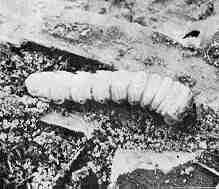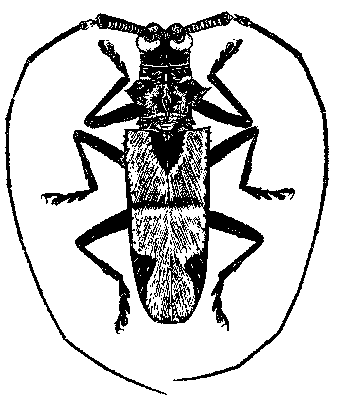Longicorn beetles lay their eggs under the bark or in cracks of the bark of their host. The larvae are almost without exception wood borers, feeding more or less host specific on wood or cambium of living and dead trees and leave an engraved pattern on the adjacent sapwood surface. The edible apod larvae are slender, slightly tapering towards the end and of white or creamy colour, except for the brown or dark head with strong mandibles. Some species tunnel deep into the heartwood or bore largely under the bark. The mature larvae tunnel into the sapwood or heartwood, form a pupal cell inside the wood and pupate in this chamber. The adults cut more or less oval emergence holes of up to 28 mm diameter through the bark after their exoskeleton is fully hardened. The life cycle takes from three months for smaller species up to more than one year for larger species.
Many species of Cerambycidae are severe pests, especially in forestry, associated with Hoop and Klinkii pines (Araucaria spp.). The longicorn beetles usually infest severely weakened and dying trees as well as felled logs. Seasoned timber is not attacked. The tunnelling does not cause structural damage, but degrades the value of the timber. Common secondary pests of Araucaria spp. and other hosts are Potemnemus detzneri, Diotimana undulata, Hyplocerambyx severus, Dihammus australis, Dihammus tincturatus, Pterolophis sp.and Coptocorynus. A peculiar pest species of Northern Queensland is the Hoop Pine Branch Pruner Strongylurus that develops in branches of Hoop pines. The adult ringbarks and prunes the branch apically to the nest resulting in the branch breaking off as if it was chopped off nicely. Pruning the branch prevents the branch from breaking where the nest is located.
The longicorn beetles include probably several thousand species on New Guinea and nearby islands among which some of the longest and most striking species can be found. The world’s longest beetle Batocera kibleri, sometimes reaching an antennae length of more than 20 cm in males, occurs on New Guinea island. Beetles of the this genus feed on breadfruit (Arthocarpus). The large and colourful Cerambycidae are of economic importance for local and international insect collectors. There are several subfamilies and genera found in PNG: Prioninae (Xixuthrus, Olethrius, Osphryon, Agrianome), Lamiinae (Glenea, Sphingnotus, Gnoma, Batocera, Dihammus, Potemnemus, Tmesisternus, Rosenbergia and Epepeotes, Lepturinae (Elacomia and Papileptura), Parandrinae (Paranda) and Cerambycinae (Coptopterus, Hyplocerambyx, Xylotrechus, Ceresium, Tethionea, Demonax)

Hyplocerambyx severus larva
(reproduced from Gray, B. &
Wylie, F.R., 1974)
Hyplocerambyx severus adult
Dihammus tincturatus
(reproduced from Gray, B. &
Wylie, F.R., 1974)

Potemnemus
detzneri
(reproduced from Gray, B. & Wylie, F.R., 1974)